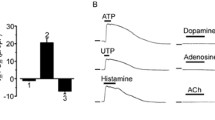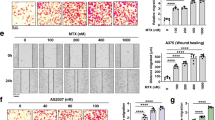Abstract
ATP, ADP, UTP, and UDP acting as ligands of specific P2Y receptors activate intracellular signaling cascades to regulate a variety of cellular processes, including proliferation, migration, differentiation, and cell death. Contrary to a widely held opinion, we show here that nucleoside 5′-O-monophosphorothioate analogs, containing a sulfur atom in a place of one nonbridging oxygen atom in a phosphate group, act as ligands for selected P2Y subtypes. We pay particular attention to the unique activity of thymidine 5′-O-monophosphorothioate (TMPS) which acts as a specific partial agonist of the P2Y6 receptor (P2Y6R). We also collected evidence for the involvement of the P2Y6 receptor in human epithelial adenocarcinoma cell line (HeLa) cell migration induced by thymidine 5′-O-monophosphorothioate analog. The stimulatory effect of TMPS was abolished by siRNA-mediated P2Y6 knockdown and diisothiocyanate derivative MRS 2578, a selective antagonist of the P2Y6R. Our results indicate for the first time that increased stability of thymidine 5′-O-monophosphorothioate as well as its affinity toward the P2Y6R may be responsible for some long-term effects mediated by this receptor.





Similar content being viewed by others
Abbreviations
- AMPS:
-
Adenosine 5′-O-monophosphorothioate
- FBS:
-
Fetal bovine serum
- HUVEC:
-
Human umbilical vein endothelial cells
- MRS 2578:
-
N,N″-1,4-butanediylbis[N′-(3-isothiocyanatophenyl)thiourea
- P2YR:
-
P2Y receptor
- TMPS:
-
Thymidine 5′-O-monophosphorothioate
- UDPβS:
-
Uridine 5′-O-(2-thiodiphosphate)
- UMPS:
-
Uridine 5′-O-monophosphorothioate
- HPLC:
-
High-performance liquid chromatography
References
Browne LE, Jiang LH, North RA (2010) New structure enlivens interest in P2X receptors. Trends Pharmacol Sci 31:229–237
Abbracchio MP, Burnstock G, Boeynaems JM, Barnard EA, Boyer JL, Kennedy C, Knight GE, Fumagalli M, Gachet C, Jacobson KA, Weisman GA (2006) International Union of Pharmacology LVIII: update on the P2Y G protein-coupled nucleotide receptors: from molecular mechanisms and pathophysiology to therapy. Pharmacol Rev 58:281–341
Communi D, Parmentier M, Boeynaems JM (1996) Cloning, functional expression and tissue distribution of the human P2Y6 receptor. Biochem Biophys Res Commun 222:303–308
Burnstock G (2007) Purine and pyrimidine receptors. Cell Mol Life Sci 64:1471–1483
Kennedy C, Qi AD, Herold CL, Harden TK, Nicholas RA (2000) ATP, an agonist at the rat P2Y4 receptor, is an antagonist at the human P2Y4 receptor. Mol Pharmacol 57:926–931
Abbracchio MP, Boeynaems JM, Barnard EA, Boyer JL, Kennedy C, Miras-Portugal MT, King BF, Gachet C, Jacobson KA, Weisman GA, Burnstock G (2003) Characterization of the UDP-glucose receptor (re-named here the P2Y14 receptor) adds diversity to the P2Y receptor family. Trends Pharmacol Sci 24:52–55
Cha SH, Hahn TW, Sekine T, Lee KH, Endou H (2000) Purinoceptor-mediated calcium mobilization and cellular proliferation in cultured bovine corneal endothelial cells. Jpn J Pharmacol 82:181–187
Satterwhite CM, Farrelly AM, Bradley ME (1999) Chemotactic, mitogenic, and angiogenic actions of UTP on vascular endothelial cells. Am J Physiol 276:H1091–H1097
Erlinge D (1998) Extracellular ATP: a growth factor for vascular smooth muscle cells. Gen Pharmacol 31:1–8
Eun SY, Ko YS, Park SW, Chang KC, Kim HJ (2015) IL-1β enhances vascular smooth muscle cell proliferation and migration via P2Y2 receptor-mediated RAGE expression and HMGB1 release. Vasc Pharmacol 72:108–117
Huang N, Wang DJ, Heppel LA (1989) Extracellular ATP is a mitogen for 3T3, 3T6, and A431 cells and acts synergistically with other growth factors. Proc Natl Acad Sci U S A 86:7904–7908
Jin H, Seo J, Eun SY, Joo YN, Park SW, Lee JH, Chang KC, Kim HJ (2014) P2Y2 R activation by nucleotides promotes skin wound-healing process. Exp Dermatol 23:480–485
Neary JT, Rathbone MP, Cattabeni F, Abbracchio MP, Burnstock G (1996) Trophic actions of extracellular nucleotides and nucleosides on glial and neuronal cells. Trends Neurosci 19:13–18
Schafer R, Sedehizade F, Welte T, Reiser G (2003) ATP- and UTP- activated P2Y receptors differently regulate proliferation of human lung epithelial tumor cells. Am J Physiol Lung Cell Mol Physiol 285:L376–L385
Muscella A, Elia MG, Greco S, Storelli C, Marsigliante S (2003) Activation of P2Y2 purinoceptor inhibits the activity of the Na+/K + −ATPase in HeLa cells. Cell Signal 15:115–121
Koziolkiewicz M, Gendaszewska E, Maszewska M, Stein CA, Stec WJ (2001) The mononucleotide-dependent, nonantisense mechanism of action of phosphodiester and phosphorothioate oligonucleotides depends upon the activity of an ecto-5′-nucleotidase. Blood 98:995–1002
Nakamura T, Murata T, Hori M, Ozaki H (2013) UDP induces intestinal epithelial migration via the P2Y6 receptor. Br J Pharmacol 170:883–892
Mamedova LK, Joshi BV, Gao ZG, von Kugelgen I, Jacobson KA (2004) Diisothiocyanate derivatives as potent, insurmountable antagonists of P2Y6 nucleotide receptors. Biochem Pharmacol 67:1763–1770
Lazarowski ER, Homolya L, Boucher RC, Harden TK (1997) Identification of an ecto-nucleoside diphosphokinase and its contribution to interconversion of P2 receptor agonists. J Biol Chem 272:20402–20407
Hou M, Harden TK, Kuhn CM, Baldetorp B, Lazarowski E, Pendergast W, Moller S, Edvinsson L (2002) UDP acts as a growth factor for vascular smooth muscle cells by activation of P2Y6 receptors. Am J Physiol Heart Circ Physiol 282:H784–H792
Moore DJ, Chambers JK, Wahlin JP, Tan KB, Moore GB, Jenkins O, Emson PC, Murdock PR (2001) Expression pattern of human P2Y receptor subtypes: a quantitative reverse transcription-polymerase chain reaction study. Biochim Biophys Acta 152:107–119
Okuda A, Furuya K, Kiyohara T (2003) ATP-induced calcium oscillations and change of P2Y subtypes with culture conditions in HeLa cells. Cell Biochem Funct 21:61–68
Welter-Stahl L, da Silva CM, Schachter J, Persechini PM, Souza HS, Ojcius DM, Coutinho-Silva R (2009) Expression of purinergic receptors and modulation of P2X7 function by the inflammatory cytokine IFNgamma in human epithelial cells. Biochim Biophys Acta 1788:1176–1187
Carter RL, Fricks IP, Barrett MO, Burianek LE, Zhou Y, Ko H, Das A, Jacobson KA, Lazarowski ER, Harden TK (2009) Quantification of Gi-mediated inhibition of adenylyl cyclase activity reveals that UDP is a potent agonist of the human P2Y14 receptor. Mol Pharmacol 76:1341–1348
Guile SD, Ince F, Ingall AH, Kindon ND, Meghani P, Mortimore MP (2001) The medicinal chemistry of the P2 receptor family. Prog Med Chem 38:115–187
Müller CE (2002) P2-pyrimidinergic receptors and their ligands. Curr Pharm Des 8:2353–2369
Gendaszewska-Darmach E, Maszewska M, Zaklos M, Koziolkiewicz M (2003) Degradation of extracellular nucleotides and their analogs in HeLa and HUVEC cell cultures. Acta Biochim Pol 50:973–984
Kim SG, Soltysiak KA, Gao ZG, Chang TS, Chung E, Jacobson KA (2003) Tumor necrosis factor α-induced apoptosis in astrocytes is prevented by the activation of P2Y6, but not P2Y4 nucleotide receptors. Biochem Pharmacol 65:923–931
Mamedova LK, Wang R, Besada P, Liang BT, Jacobson KA (2008) Attenuation of apoptosis in vitro and ischemia/reperfusion injury in vivo in mouse skeletal muscle by P2Y6 receptor activation. Pharmacol Res 58:232–239
Korcok J, Raimundo LN, Du X, Sims SM, Dixon SJ (2005) P2Y6 nucleotide receptors activate NF-κB and increase survival of osteoclasts. J Biol Chem 280:16909–16915
Koizumi S, Shigemoto-Mogam Y, Nasu-Tada K, Shinozaki Y, Ohsawa K, Tsuda M, Joshi BV, Jacobson KA, Kohsaka S, Inoue K (2007) UDP acting at P2Y6 receptors is a novel mediator of microglial phagocytosis. Nature 446:1091–1095
Köttgen M, Löffler T, Jacobi C, Nitschke R, Pavenstädt H, Schreiber R, Frische S, Nielsen S, Leipziger J (2003) P2Y6 receptor mediates colonic NaCl secretion via differential activation of cAMP-mediated transport. J Clin Invest 111:371–379
Bar I, Guns PJ, Metallo J, Cammarata D, Wilkin F, Boeynams JM, Bult H, Robaye B (2008) Knockout mice reveal a role for P2Y6 receptor in macrophages, endothelial cells, and vascular smooth muscle cells. Mol Pharmacol 74:777–784
Balasubramanian R, Ruiz de Azua I, Wess J, Jacobson KA (2010) Activation of distinct P2Y receptor subtypes stimulates insulin secretion in MIN6 mouse pancreatic beta cells. Biochem Pharmacol 79:1317–1326
Markovskaya A, Crooke A, Guzmán-Aranguez AI, Peral A, Ziganshin AU, Pintor J (2008) Hypotensive effect of UDP on intraocular pressure in rabbits. Eur J Pharmacol 579:93–597
Zhang Z, Wang Z, Ren H, Yue M, Huang K, Gu H, Liu M, Du B, Qian M (2011) P2Y(6) agonist uridine 5′-diphosphate promotes host defense against bacterial infection via monocytechemoattractant protein-1-mediated monocytes/macrophages recruitment. J Immunol 86:5376–5387
El-Tayeb A, Qi A, Nicholas RA, Müller CE (2011) Structural modifications of UMP, UDP, and UTP leading to subtype-selective agonists for P2Y2, P2Y4, and P2Y6 receptors. J Med Chem 54:2878–2890
El-Tayeb A, Qi A, Müller CE (2006) Synthesis and structure-activity relationships of uracil nucleotide derivatives and analogues as agonists at human P2Y2, P2Y4, and P2Y6 receptors. J Med Chem 49:7076–7087
Boyer JL, Siddiqi S, Fischer B, Romero-Avila T, Jacobson KA, Harden TK (1996) Identification of potent P2Y-purinoceptor agonists that are derivatives of adenosine 5′-monophosphate. Br J Pharmacol 8:1959–1964
Cristalli G, Podda GM, Costanzi S, Lambertucci C, Lecchi A, Vittori S, Volpini R, Zighetti ML, Cattaneo M (2005) Effects of 5′-phosphate derivatives of 2-hexynyl adenosine and 2-phenylethynyl adenosine on responses of human platelets mediated by P2Yreceptors. J Med Chem 48:2763–2766
Communi D, Robaye B, Boeynaems JM (1999) Pharmacological characterization of the human P2Y11 receptor. Br J Pharmacol 128:1199–1206
Conigrave AD, Lee JY, van der Weyden L, Jiang L, Ward P, Tasevski V, Luttrell BM, Morris MB (1998) Pharmacological profile of a novel cyclicAMP-linked P2 receptor on undifferentiated HL-60 leukemia cells. Br J Pharmacol 124:1580–1585
Jacobson KA, Ivanov AA, de Castro S, Harden TK, Ko H (2009) Development of selective agonists and antagonists of P2Y receptors. Purinergic Signal 5:75–89
Besada P, Shin DH, Costanzi S, Ko H, Mathé C, Gagneron J, Gosselin G, Maddileti S, Harden TK, Jacobson KA (2006) Structure-activity relationships of uridine 5′-diphosphate analogues at the human P2Y6 receptor. J Med Chem 49:5532–5543
Costanzi S, Joshi BV, Maddileti S, Mamedova M, Gonzalez-Moa MJ, Marquez VE, Harden TK, Jacobson KA (2005) Human P2Y(6) receptor: molecular modeling leads to the rational design of a novel agonist based on a unique conformational preference. J Med Chem 48:8108–8111
Maruoka H, Barrett MO, Ko H, Tosh DK, Melman A, Burianek LE, Balasubramanian R, Berk B, Costanzi S, Harden TK, Jacobson KA (2010) Pyrimidine ribonucleotides with enhanced selectivity as P2Y(6) receptor agonists: novel 4-alkyloxyimino, (S)-methanocarba, and 5′-triphosphate gamma-ester modifications. J Med Chem 53:4488–4501
Meltzer D, Ethan O, Arguin G, Nadel Y, Danino O, Lecka J, Sévigny J, Gendron FP, Fischer B (2015) Synthesis and structure-activity relationship of uracil nucleotide derivatives towards the identification of human P2Y6 receptor antagonists. Bioorg Med Chem 23:5764–5773
Frey PA, Sammons RD (1985) Bond order and charge localization in nucleoside phosphorothioates. Science 228:541–545
Da Costa CP, Okruszek A, Sigel H (2003) Complex formation of divalent ions with uridine 5′-thiomonophosphate or methyl thiophosphate: comparison of complex stabilities with those of the parent phosphate ligands. ChemBioChem 4:593–602
Major DT, Nahum V, Wang Y, Reiser G, Fisher B (2004) Molecular recognition in purinergic receptors. 2. Diastereoselectivity of the h-P2Y1-receptor. J Med Chem 47:4405–4416
Węgłowska E, Szustak M, Gendaszewska-Darmach E (2015) Proangiogenic properties of nucleoside 5′-O-phosphorothioate analogues under hyperglycaemic conditions. Curr Top Med Chem 15:2464–2474
Guga P, Koziołkiewicz M (2011) Phosphorothioate nucleotides and oligonucleotides - recent progress in synthesis and application. Chem Biodivers 8:1642–1681
Acknowledgments
The study was supported by the Ministry of Science and Higher Education (Project No. N 405 3047 36).
Author information
Authors and Affiliations
Corresponding author
Ethics declarations
Conflict of interest
The authors confirm that this article content has no conflict of interest.
Rights and permissions
About this article
Cite this article
Gendaszewska-Darmach, E., Szustak, M. Thymidine 5'-O-monophosphorothioate induces HeLa cell migration by activation of the P2Y6 receptor. Purinergic Signalling 12, 199–209 (2016). https://doi.org/10.1007/s11302-015-9492-1
Received:
Accepted:
Published:
Issue Date:
DOI: https://doi.org/10.1007/s11302-015-9492-1




